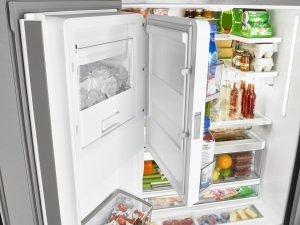1. Why Do Refrigerators Have a Water Line?
A refrigerator is an essential home appliance to keep your food preserved and drinks cool. If your refrigerator has a built in water dispenser or automatic ice maker, it will require a connection to a water source. There are some models that have a reservoir, where you can add water manually, but the most convenient solution is to connect the refrigerator directly to your home plumbing via a water line.
2. When is a Water Line Unnecessary?
While refrigerators with a water line remain popular, they are not always necessary. There are refrigerator models that don’t have a water line, but you’ll need to sacrifice an automatic ice maker or built in water dispenser.
However, there is an advantage to losing these features on your refrigerator. You can have a refrigerator with greater storage capacity. Automatic ice makers and water dispensers take up a significant portion of the door space. If you have a French door refrigerator without these features, you’ll find you have far more space compared to a model with them.
If you’re happy to have a standalone water dispenser or countertop ice maker, you may find having a refrigerator water line unnecessary. But, the decision about whether a water line is needed for your refrigerator will depend on your kitchen layout, preferences, and requirements.
3. Can You Add a Water Line to Your Refrigerator?
If you’re having problems with your refrigerator water line or you want to install one, it is a relatively simple process. Generally, the water line is a 1/4 inch bendable copper tubing that is attached to the nearest water source at one end and connected to the refrigerator at the other.
However, there are other water line options on the market that may cost a little more, but are less vulnerable to leaks. There are no restrictions on how long a water line can be. So, if your refrigerator is at one end of your kitchen and the sink is at the other, you could have a water line that is up to twenty feet long. Since the line could have a number of bends to accommodate the characteristics of your kitchen layout, you need to feel confident that the line is good quality and will not be prone to leaking.
4. Warning Signs of a Refrigerator Water Line Leak
If you’re unsure about the quality of your water line and have concerns about leaks, there are some signs to look out for.
- Water accumulation: The most obvious sign of a water line leak is puddles of water that accumulate under or around the base of your refrigerator. If the refrigerator is sitting on a rug, you may notice a damp patch in the area.
- Baseboard damage: If the leak has been a problem for a while, you may notice baseboard damage. You may see cracked paint, wood swelling, water line stains or even mold and mildew.
- Smaller ice cubes: If the leak is due to a malfunctioning valve, you may notice that your ice cubes are smaller than usual or the ice maker won’t automatically shut off.
If you have concerns about your refrigerator water line, you can rely on the expertise of an appliance repair specialist to detect any underlying issues and offer an effective solution.
